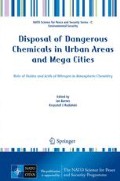Abstract
Recent field evidence shows the presence of nitro-phenolic compounds in biomass burning influenced secondary organic aerosol. The results from laboratory and smog chamber experiments suggest that these compounds likely form from the reaction of gas-phase phenolic compounds originating from biomass burning in the presence of NOx. These compounds contribute as much as 3.8% to the organic carbon fraction of wintertime aerosols collected in a rural German village, indicating that they are important secondary organic aerosol constituents during the winter months.
Access this chapter
Tax calculation will be finalised at checkout
Purchases are for personal use only
References
Altieri KE, Turpin BJ, Seitzinger SP (2009) Composition of dissolved organic nitrogen in continental precipitation investigated by ultra-high resolution FT-ICR mass spectrometry. Environ Sci Technol 43:6950–6955
Altieri KE, Turpin BJ, Seitzinger SP (2009) Oligomers, organosulfates, and nitrooxy organosulfates in rainwater identified by ultra-high resolution electrospray ionization FT-ICR mass spectrometry. Atmos Chem Phys 9:2533–2542
Anastasio C, Sun J (2009) SOA formation via aqueous reactions of phenols from wood combustion. Geochim Cosmochim Ac 73:A39
Atkinson R, Aschmann SM, Arey J (1992) Reactions of OH and NO3 radicals with phenol, cresols, and 2-nitrophenol at 296-K+-2-K. Environ Sci Technol 26:1397–1403
Barzaghi P, Herrmann H (2002) A mechanistic study of the oxidation of phenol by OH/NO2/NO3 in aqueous solution. Phys Chem Chem Phys 4:3669–3675
Goldstein AH, Galbally IE (2007) Known and unexplored organic constituents in the earth’s atmosphere. Environ Sci Technol 41:1514–1521
Gómez-González Y, Surratt JD, Cuyckens F, Szmigielski R, Vermeylen R, Jaoui M, Lewandowski M, Offenberg JH, Kleindienst TE, Edney EO, Blockhuys F, Van Alsenoy C, Maenhaut W, Claeys M (2008) Characterization of organosulfates from the photooxidation of isoprene and unsaturated fatty acids in ambient aerosol using liquid chromatography/(-) electrospray ionization mass spectrometry. J Mass Spectrom 43:371–382
Grieshop AP, Donahue NM, Robinson AL (2009) Laboratory investigation of photochemical oxidation of organic aerosol from wood fires 2: analysis of aerosol mass spectrometer data. Atmos Chem Phys 9:2227–2240
Grieshop AP, Logue JM, Donahue NM, Robinson AL (2009) Laboratory investigation of photochemical oxidation of organic aerosol from wood fires 1: measurement and simulation of organic aerosol evolution. Atmos Chem Phys 9:1263–1277
Hallquist M, Wenger JC, Baltensperger U, Rudich Y, Simpson D, Claeys M, Dommen J, Donahue NM, George C, Goldstein AH, Hamilton JF, Herrmann H, Hoffmann T, Iinuma Y, Jang M, Jenkin ME, Jimenez JL, Kiendler-Scharr A, Maenhaut W, McFiggans G, Mentel TF, Monod A, Prevot ASH, Seinfeld JH, Surratt JD, Szmigielski R, Wildt J (2009) The formation, properties and impact of secondary organic aerosol: current and emerging issues. Atmos Chem Phys 9:5155–5236
Iinuma Y, Müller C, Berndt T, Böge O, Claeys M, Herrmann H (2007) Evidence for the existence of organosulfates from β-pinene ozonolysis in ambient secondary organic aerosol. Environ Sci Technol 41:6678–6683
Iinuma Y, Böge O, Gräfe R, Herrmann H (2010) Methyl-nitrocatechols: atmospheric tracer compounds for biomass burning secondary organic aerosols. Environ Sci Technol 44:8453–8459
Kristensen K, Glasius M (2011) Organosulfates and oxidation products from biogenic hydrocarbons in fine aerosols from a forest in North West Europe during spring. Atmos Environ 45:4546–4556
Lukács H, Gelencsér A, Hoffer A, Kiss G, Horváth K, Hartyáni Z (2009) Quantitative assessment of organosulfates in size-segregated rural fine aerosol. Atmos Chem Phys 9:231–238
Maenhaut W, Raes N, Chi XG, Cafmeyer J, Wang W (2008) Chemical composition and mass closure for PM2.5 and PM10 aerosols at K-puszta, Hungary, in summer 2006. X-Ray Spectrom 37:193–197
Schauer JJ, Kleeman MJ, Cass GR, Simoneit BRT (2001) Measurement of emissions from air pollution sources. 3. C-1-C-29 organic compounds from fireplace combustion of wood. Environ Sci Technol 35:1716–1728
Sun YL, Zhang Q, Anastasio C, Sun J (2010) Insights into secondary organic aerosol formed via aqueous-phase reactions of phenolic compounds based on high resolution mass spectrometry. Atmos Chem Phys 10:4809–4822
Surratt JD, Gomez-Gonzalez Y, Chan AWH, Vermeylen R, Shahgholi M, Kleindienst TE, Edney EO, Offenberg JH, Lewandowski M, Jaoui M, Maenhaut W, Claeys M, Flagan RC, Seinfeld JH (2008) Organosulfate formation in biogenic secondary organic aerosol. J Phys Chem A 112:8345–8378
van Pinxteren D, Bruggemann E, Gnauk T, Iinuma Y, Muller K, Nowak A, Achtert P, Wiedensohler A, Herrmann H (2009) Size- and time-resolved chemical particle characterization during CAREBeijing-2006: different pollution regimes and diurnal profiles. J Geophys Res [Atmos] 114. doi:10.1029/2008JD010890
Author information
Authors and Affiliations
Corresponding author
Editor information
Editors and Affiliations
Rights and permissions
Copyright information
© 2013 Springer Science+Business Media Dordrecht
About this paper
Cite this paper
Iinuma, Y., Herrmann, H. (2013). Nitro- and Nitro-Oxy-Compounds in Multiphase Particle Chemistry: Field and Analytical Studies. In: Barnes, I., Rudziński, K. (eds) Disposal of Dangerous Chemicals in Urban Areas and Mega Cities. NATO Science for Peace and Security Series C: Environmental Security. Springer, Dordrecht. https://doi.org/10.1007/978-94-007-5034-0_15
Download citation
DOI: https://doi.org/10.1007/978-94-007-5034-0_15
Published:
Publisher Name: Springer, Dordrecht
Print ISBN: 978-94-007-5033-3
Online ISBN: 978-94-007-5034-0
eBook Packages: Earth and Environmental ScienceEarth and Environmental Science (R0)

